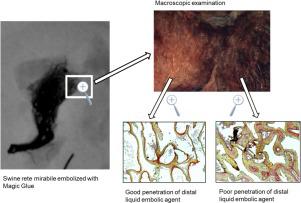Journal of Neuroradiology ( IF 3.5 ) Pub Date : 2021-01-05 , DOI: 10.1016/j.neurad.2020.12.005 Lorena Nico 1 , Elsa Magro 2 , Julien Ognard 3 , Robert Fahed 4 , Igor Salazkin 5 , Guylaine Gevry 5 , Tim Darsaut 6 , Jean Raymond 7 , Jean-Christophe Gentric 8

|
Background
The pressure cooker (PC) technique uses a second microcatheter to produce a proximal occlusion to prevent the reflux of liquid embolic agent (LEA) injected through a more distal microcatheter, and can be used to treat arteriovenous malformations and dural arteriovenous fistulae. The liquid embolic Magic Glue (MG) (N-hexyl cyanoacrylate (NHCA)) has been introduced as an alternative to N-butyl cyanoacrylate (NBCA). Our goals were to compare the extent of embolization of rete mirabile with or without the PC technique using NBCA or MG, and to compare the proximal occlusions obtained with MG or NBCA while using the PC technique in a renal arterial model.
Methods
Rete mirabile were embolized with (n = 4) and without (n = 4) the PC technique, using MG (n = 4) or NBCA (n = 4). A renal arterial model was then used to study the characteristics of the MG plug (n = 10) used for the PC technique, and resistance to catheter withdrawal as compared to NBCA (n = 4). Specimens were analyzed macro- and microscopically and compared to angiographic results.
Results
Extent of rete embolization with CYA agents was not significantly greater when using the PC technique. Results were similar with both types of cyanoacrylate (p = 0.657). The force necessary to withdraw the microcatheter was less with MG than with NBCA (p = 0.035).
Conclusion
MG was similar to NBCA in extent of rete embolization. Less traction force was necessary to withdraw trapped non-detachable microcatheters using MG compared to NBCA.
中文翻译:

使用高压锅技术比较氰基丙烯酸正己酯(魔术胶)和氰基丙烯酸正丁酯(NBCA)用于神经血管栓塞:猪的实验研究
背景
压力锅 (PC) 技术使用第二个微导管产生近端闭塞,以防止通过更远端微导管注射的液体栓塞剂 (LEA) 回流,可用于治疗动静脉畸形和硬脑膜动静脉瘘。液体栓塞魔术胶 (MG)(氰基丙烯酸正己酯 (NHCA))已被引入作为氰基丙烯酸正丁酯 (NBCA) 的替代品。我们的目标是比较使用 NBCA 或 MG 使用或不使用 PC 技术对神奇网的栓塞程度,并比较在肾动脉模型中使用 PC 技术时使用 MG 或 NBCA 获得的近端闭塞。
方法
使用 MG (n = 4) 或 NBCA (n = 4) 使用 (n = 4) 和不使用 (n = 4) PC 技术栓塞 Rete mirabile。然后使用肾动脉模型来研究用于 PC 技术的 MG 塞(n = 10)的特性,以及与 NBCA(n = 4)相比对拔管的阻力。对标本进行宏观和微观分析,并与血管造影结果进行比较。
结果
使用 PC 技术时,CYA 药物的视网膜栓塞程度并没有显着增加。两种氰基丙烯酸酯的结果相似(p = 0.657)。MG 撤回微导管所需的力比 NBCA 小(p = 0.035)。
结论
MG 的网状栓塞程度与 NBCA 相似。与 NBCA 相比,使用 MG 撤回被困的不可分离微导管所需的牵引力更小。



























 京公网安备 11010802027423号
京公网安备 11010802027423号